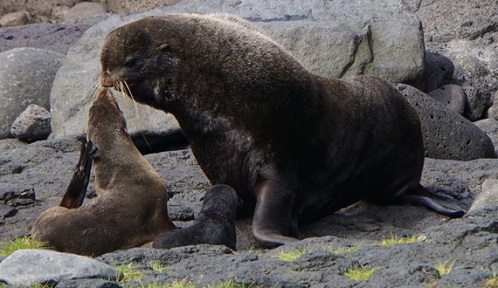
During breeding season, three-quarters of the Northern Fur Seal population can be found on the Pribilof Islands. They can dive to depths of 600 feet searching for small fish and squid. (Photo: Dahr Jamail)
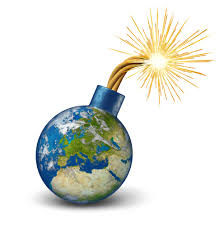
I’m standing atop Rush Hill on Alaska's remote St. Paul Island. While only 665 feet high, it provides a 360-degree view of this tundra-covered, 13-mile-long, seven-mile-wide part of the Pribilof Islands. While the hood of my rain jacket flaps in the cold wind, I gaze in wonder at the silvery waters of the Bering Sea. The ever-present wind whips the surface into a chaos of whitecaps, scudding mist, and foam.
The ancient cinder cone I’m perched on reminds me that St. Paul, was, oh so long ago, one of the last places woolly mammoths could be found in North America. I’m here doing research for my book The End of Ice. And that, in turn, brings me back to the new reality in these far northern waters: as cold as they still are, human-caused climate disruption is warming them enough to threaten a possible collapse of the food web that sustains this island’s Unangan, its Aleut inhabitants, also known as “the people of the seal.” Given how deeply their culture is tied to a subsistence lifestyle coupled with the new reality that the numbers of fur seals, seabirds, and other marine life they hunt or fish are dwindling, how could this crisis not be affecting them?
While on St. Paul, I spoke with many tribal elders who told me stories about fewer fish and sea birds, harsher storms and warming temperatures, but what struck me most deeply were their accounts of plummeting fur seal populations. Seal mothers, they said, had to swim so much farther to find food for their pups that the babies were starving to death before they could make it back.
And the plight of those dramatically declining fur seals could well become the plight of the Unangan themselves, which in the decades to come, as climate turbulence increases, could very well become the plight of all of us.

During breeding season, three-quarters of the Northern Fur Seal population can be found on the Pribilof Islands. They can dive to depths of 600 feet searching for small fish and squid. (Photo: Dahr Jamail)
Just before flying to St. Paul, I met with Bruce Wright in Anchorage, Alaska. He’s a senior scientist with the Aleutian Pribilof Islands Association, has worked for the National Marine Fisheries Service, and was a section chief for the National Oceanic and Atmospheric Administration for 11 years. "We're not going to stop this train wreck," he assures me grimly. "We are not even trying to slow down the production of CO2 [carbon dioxide], and there is already enough CO2 in the atmosphere.”
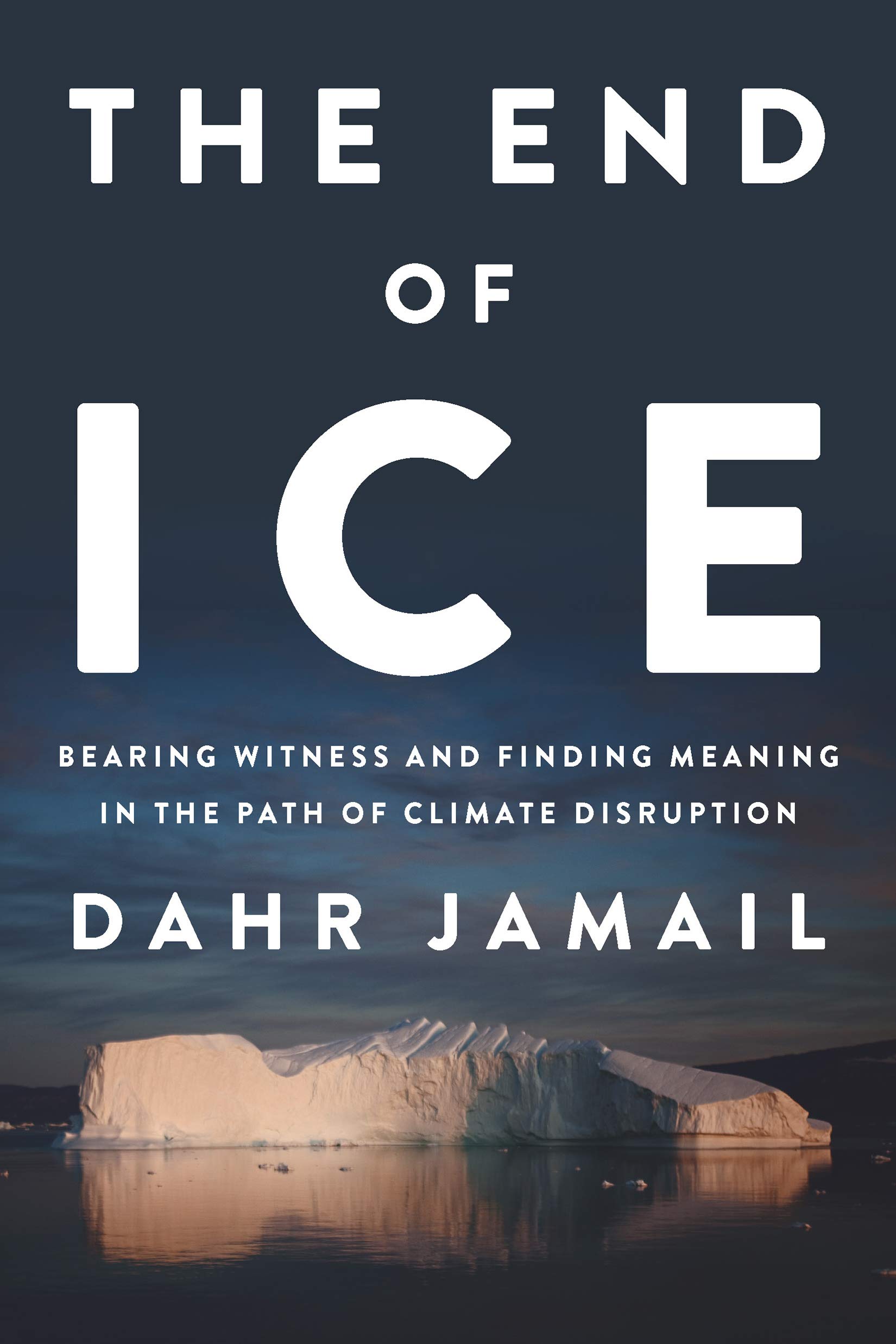
Buy the Book
While describing the warming, ever more acidic waters around Alaska and the harm being caused to the marine food web, he recalled a moment approximately 250 million years ago when the oceans underwent similar changes and the planet experienced mass extinction events “driven by ocean acidity. The Permian mass extinction where 90% of the species were wiped out, that is what we are looking at now."
I wrap up the interview with a heavy heart, place my laptop in my satchel, put on my jacket, and shake his hand. Knowing I’m about to fly to St. Paul, Wright has one final thing to tell me as he walks me out: "The Pribilofs were the last place mammoths survived because there weren’t any people out there to hunt them. We’ve never experienced this, where we are headed. Maybe the islands will become a refuge for a population of humans."
The Loss Upon Us
For at least two decades, I've found my solace in the mountains. I lived in Alaska from 1996 to 2006 and more than a year of my life has been spent climbing on the glaciers of Denali and other peaks in the Alaska Range. Yet that was a bittersweet time for me as the dramatic impacts of climate change were quickly becoming apparent, including quickly receding glaciers and warmer winter temperatures.
After years of war and then climate-change reporting, I regularly withdrew to the mountains to catch my breath. As I filled my lungs with alpine air, my heart would settle down and I could feel myself root back into the Earth.
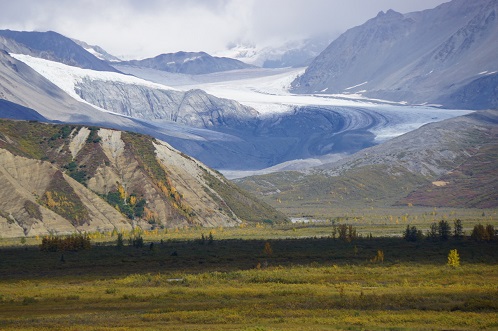
The Gulkana Glacier in the Alaska Range, like most glaciers globally, is losing mass rapidly. Some experts predict that every alpine glacier in the world will be gone by 2100.
Later, my book research would take me back onto Denali's fast-shrinking glaciers and also to Glacier National Park in Montana. There I met Dr. Dan Fagre, a U.S. Geological Survey research ecologist and director of the Climate Change in Mountain Ecosystems Project. "This is an explosion," he assured me, "a nuclear explosion of geologic change. This... exceeds the ability for normal adaptation. We've shoved it into overdrive and taken our hands off the wheel." Despite its name, the park he studies is essentially guaranteed not to have any active glaciers by 2030, only 11 years from now.
My research also took me to the University of Miami, Coral Gables, where I met the chair of the Department of Geological Science, Harold Wanless, an expert in sea-level rise.
I asked him what he would say to people who think we still have time to mitigate the impacts of runaway climate change. "We can't undo this," he replied. "How are you going to cool down the ocean? We're already there."
As if to underscore the point, Wanless told me that, in the past, carbon dioxide had varied from roughly 180 to 280 parts per million (ppm) in the atmosphere as the Earth shifted from glacial to interglacial periods. Linked to this 100-ppm fluctuation was about a 100-foot change in sea level. "Every 100-ppm CO2 increase in the atmosphere gives us 100 feet of sea level rise," he told me. "This happened when we went in and out of the Ice Age."
As I knew, since the industrial revolution began, atmospheric CO2 has already increased from 280 to 410 ppm. "That’s 130 ppm in just the last 200 years," I pointed out to him. "That’s 130 feet of sea level rise that’s already baked into Earth's climate system."
He looked at me and nodded grimly. I couldn’t help thinking of that as a nod goodbye to coastal cities from Miami to Shanghai.
In July 2017, I traveled to Camp 41 in the heart of the Brazilian Amazon rainforest, part of a project founded four decades ago by Thomas Lovejoy, known to many as the "godfather of biodiversity." While visiting him, I also met Vitek Jirinec, an ornithologist from the Czech Republic who had held 11 different wildlife positions from Alaska to Jamaica. In the process, he became all too well acquainted with the signs of biological collapse among the birds he was studying. He'd watched as some Amazon populations like that of the black-tailed leaftosser declined by 95%; he'd observed how mosquitoes in Hawaii were killing off native bird populations; he'd explored how saltwater intrusion into Alaska's permafrost was changing bird habitats there.
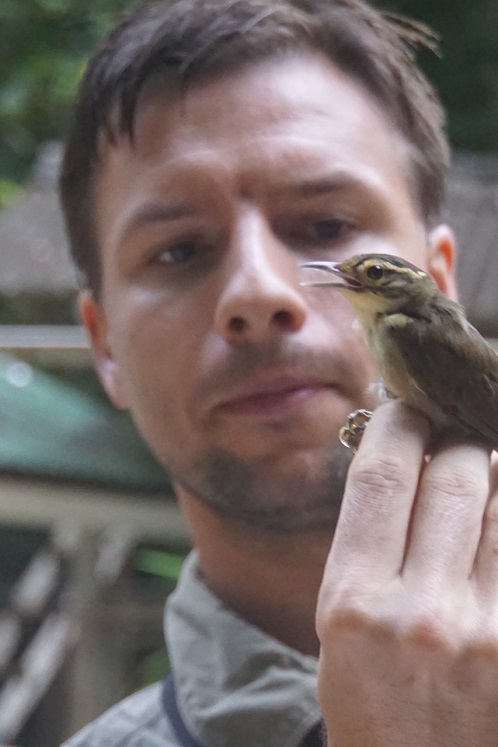
Orinthologist Vitek Jirinec at Camp 41. Some bird species in the Amazon have already declined by 95% since the 1980s.
His tone turned somber as we discussed his research and a note of anger slowly crept into his voice. "The problem of animal and plant populations left marooned within various fragments [of their habitat] under circumstances that are untenable for the long term has begun showing up all over the land surface of the planet. The familiar questions recur: How many mountain gorillas inhabit the forested slopes of the Virunga volcanoes, along the shared borders of the Democratic Republic of the Congo, Uganda, and Rwanda? How many tigers live in the Sariska Tiger Reserve of northwestern India? How many are left? How long can they survive?"
As he continued, the anger in his voice became palpable, especially when he began discussing how “island biogeography” had come to the mainland and what was happening to animal populations marooned by human development on fragments of land in places like the Amazon. "How many grizzly bears occupy the North Cascades ecosystem, a discrete patch of mountain forest along the northern border of the state of Washington? Not enough. How many European brown bears are there in Italy's Abruzzo National Park? Not enough. How many Florida panthers in Big Cypress Swamp? Not enough. How many Asiatic lions in the Forest of Gir? Not enough... The world is broken in pieces now.”
"A Terrifying 12 Years"
In October 2018, 15 months after Jirinec's words brought me to tears in the Amazon, the world's leading climate scientists authored a report for the U.N. Intergovernmental Panel on Climate Change (IPCC) warning us that we have just a dozen years left to limit the catastrophic impacts of climate change. The gist of it is this: we’ve already warmed the planet one degree Celsius. If we fail to limit that warming process to 1.5 degrees, even a half-degree more than that will significantly worsen extreme heat, flooding, widespread droughts, and sea level increases, among other grim phenomena. The report has become a key talking point of political progressives in the U.S., who, like journalist and activist Naomi Klein, are now speaking of "a terrifying 12 years" left in which to cut fossil fuel emissions.
There is, however, a problem with even this approach. It assumes that the scientific conclusions in the IPCC report are completely sound. It’s well known, however, that there’s been a political element built into the IPCC’s scientific process, based on the urge to get as many countries as possible on board the Paris climate agreement and other attempts to rein in climate change. To do that, such reports tend to use the lowest common denominator in their projections, which makes their science overly conservative (that is, overly optimistic).
In addition, new data suggest that the possibility of political will coalescing across the planet to shift the global economy completely off fossil fuels in the reasonably near future is essentially a fantasy. And that’s even if we could remove enough of the hundreds of billions of tons of CO2 already in our overburdened atmosphere to make a difference (not to speak of the heat similarly already lodged in the oceans).
"It's extraordinarily challenging to get to the 1.5 degree Celsius target and we are nowhere near on track to doing that," Drew Shindell, a Duke University climate scientist and a co-author of the IPCC report, told the Guardian just weeks before it was released. "While it's technically possible, it’s extremely improbable, absent a real sea change in the way we evaluate risk. We are nowhere near that."
In fact, even best-case scenarios show us heading for at least a three-degree warming and, realistically speaking, we are undoubtedly on track for far worse than that by 2100, if not much sooner. Perhaps that’s why Shindell was so pessimistic.
For example, a study published in Nature magazine, also released in October, showed that over the last quarter-century, the oceans have absorbed 60% more heat annually than estimated in the 2014 IPCC report. The study underscored that the globe’s oceans have, in fact, already absorbed 93% of all the heat humans have added to the atmosphere, that the climate system's sensitivity to greenhouse gases is far higher than thought and that planetary warming is far more advanced than had previously been grasped.
To give you an idea of how much heat the oceans have absorbed: if that heat had instead gone into the atmosphere, the global temperature would be 97 degrees Fahrenheit hotter than it is today. For those who think that there are still 12 years left to change things, the question posed by Wanless seems painfully apt: How do we remove all the heat that’s already been absorbed by the oceans?
Two weeks after that Nature article came out, a study in Scientific Reports warned that the extinction of animal and plant species thanks to climate change could lead to a "domino effect" that might, in the end, annihilate life on the planet. It suggested that organisms will die out at increasingly rapid rates because they depend on other species that are also on their way out. It’s a process the study calls "co-extinction." According to its authors, a five to six degree Celsius rise in average global temperatures might be enough to annihilate most of Earth’s living creatures.
To put this in perspective: just a two degree rise will leave dozens of the world's coastal mega-cities flooded, thanks primarily to melting ice sheets in Greenland and Antarctica, as well as the thermal expansion of the oceans as they warm. There will be 32 times as many heat waves in India and nearly half a billion more people will suffer water scarcity. At three degrees, southern Europe will be in permanent drought and the area burned annually by wildfires in the U.S. will sextuple. These impacts, it’s worth noting, may already be baked into the system, even if every country that signed the Paris climate accord were to fully honor its commitments, which most of them are not currently doing.
At four degrees, global grain yields could drop by half, most likely resulting in annual worldwide food crises (along with far more war, general conflict, and migration than at present).
The International Energy Agency has already shown that maintaining our current fossil-fueled economic system would virtually guarantee a six-degree rise in the Earth’s temperature before 2050. To add insult to injury, a 2017 analysis from oil giants BP and Shell indicated that they expected the planet to be five degrees warmer by mid-century.
In late 2013, I wrote a piece for TomDispatch titled "Are We Falling Off the Climate Precipice?" Even then, it was already clear enough that we were indeed heading off that cliff. More than five years later, a sober reading of the latest climate change science indicates that we are now genuinely in free fall.
The question is no longer whether or not we are going to fail, but how are we going to comport ourselves in the era of failure?
Listening While Saying Goodbye
It’s been estimated that between 150 and 200 plant, insect, bird, and mammal species are already going extinct every day. In other words, during the two and a half years I worked on my book 136,800 species may have gone extinct.
We have a finite amount of time left to coexist with significant parts of the biosphere, including glaciers, coral, and thousands of species of plants, animals, and insects. We’re going to have to learn how to say goodbye to them, part of which should involve doing everything we humanly can to save whatever is left, even knowing that the odds are stacked against us.
For me, my goodbyes will involve spending as much time as I can on the glaciers in Washington State’s Olympic National Park and North Cascades National Park near where I live, or far more modestly taking in the trees around my home on a daily basis. It’s unclear, after all, how much longer such forest areas are likely to remain fully intact. I often visit a small natural altar I’ve created amid a circle of cedar trees growing around a decomposing mother tree. In this magical spot, I grieve and express my gratitude for the life that is still here. I also go to listen.
Where do you go to listen? And what are you hearing?
For me, these days, it all begins and ends with doing my best to listen to the Earth, with trying my hardest to understand how best to serve, how to devote myself to doing everything possible for the planet, no matter the increasingly bleak prognosis for this time in human history.
Perhaps if we listen deeply enough and regularly enough, we ourselves will become the song this planet needs to hear.
Dahr Jamail, a Tom Dispatch regular, is a recipient of numerous honors, including the Martha Gellhorn Award for Journalism for his work in Iraq and the Izzy Award for Outstanding Achievement in Independent Media in 2018. His newest book, The End of Ice: Bearing Witness and Finding Meaning in the Path of Climate Disruption (The New Press), has just been published. He is also the author of Beyond the Green Zone and The Will to Resist. He is a staff reporter for Truthout.
[Note: This piece was co-published with Truthout.org.]
Follow TomDispatch on Twitter and join us on Facebook. Check out the newest Dispatch Books, John Feffer’s new dystopian novel (the second in the Splinterlands series) Frostlands, Beverly Gologorsky's novel Every Body Has a Story, and Tom Engelhardt's A Nation Unmade by War, as well as Alfred McCoy's In the Shadows of the American Century: The Rise and Decline of U.S. Global Power and John Dower's The Violent American Century: War and Terror Since World War II.
Copyright 2019 Dahr Jamail
Thanks to TomDispatch.com